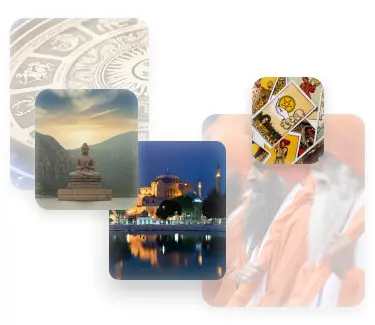The teaching is widespread on all five continents.
Kabbalah
Kabbalah is a Hebrew system of knowledge, literally “the soul of the soul of the law.” The teachings were kept and passed on only to the highest caste of the initiates of Jewish society. According to ancient legends, Moses comprehended the soul of the soul of the law on Mount Sinai for 40 days before he formalized his research in manuscripts and sacred scrolls.
The exact number is unknown, at least 100 thousand.
According to Christian Ginzburg (famous biblical scholar of the 9th-20th centuries), Kabbalah as a system of knowledge passed from Adam to Noah, from him to Abraham, and then to Moses, and part of the knowledge leaked to other peoples surrounding Jews and Egyptians. In the late 20th and early 21st centuries, Kabbalah gained notable popularity in Europe and the Americas.
Kabbalah often appears in topics concerning magic or unexplained phenomena of nature or society. The topic is quite popular in the media, again among the world conspiracies.
The teachings of Berg and Lightman have been repeatedly criticized by rabbis and Kabbalists because of the reinterpretation of the provisions prescribed in the Torah.
Short story
Kabbalah was formed under the influence of the mysteries and ancient rituals in the Middle East. The oldest known texts date back to the 1st century AD, but in its modern form this doctrine was formed in the 12th century AD. it was during this period that the so-called Zhernoska school was formed on the territory of Spain, captured by the Arabs.
In modern times, Kabbalah develops within the Jewish Hasidic sects. During the 20th century, the teachings of Kabbalah were actively used to analyze contemporary problems of society and man in particular. Zionist rabbi Abraham Isaac Kook attempted to combine the teachings of Zionism and Kabbalah in order to ensure a reliable dialogue between Jews and God. Baal HaSulam (Rav Yehuda Ashlag) played an important role in popularizing the teachings in the 20th century. He is the author of a series of religious works, textbooks on Kabbalah, in particular, Talmud Esar Sefirot.
The essence of the teaching
Kabbalah considers the teaching of the “Torah” as a systematic mystical code, using which one can study the relationship between Ein Sof – the eternal unchangeable being, the Lord, and His creation – our finite material world.
The nature of Ein Sof is a circle, a symbol of eternity, within which its centers arise, which can be compared with forms of order, temporal and finite against the background of Ein Sof. Our whole life takes place within the framework of the “cosmic egg”, which will be split during the Great Day when the whole world returns to the beginning of all things.
Kabbalah is usually divided into 5 main directions:
- Natural Kabbalah. The main importance is the comprehension of the mysteries of the natural or material world.
- Analogical Kabbalah. The teaching is aimed at studying all the subtleties of the relationship between things in nature. Man is only a small universe, repeating the surrounding macrocosm in everything.
- Contemplative Kabbalah. It is based on abstract thinking and higher intellectual efforts aimed at revealing the secrets of the heavenly spheres and the creatures living in them.
- Astrological Kabbalah. A knowledge system that allows you to evaluate and analyze the secrets of the planet and its mystical structure.
- Mystical Kabbalah. Helps the practitioner gain power over the creatures of the invisible world and demons living beyond the mind.
At the same time, Kabbalah has its own system of counting, echoing numerology. For example, in the counting system, 10 is the number of Sephiroth, literally “the number of the creator.” The number 7 is the number of magic, and 3 is the number of 3 mother letters. They are the number of creators of the material universe, and the number of 3 great forces in the world. The power of the male active, the power of the female receiver, as well as the power of balancing are the directions that allow the practitioner to choose a goal for the realization of his plans.
At the center of the Kabbalah teaching is the Sephiroth tree, which contains the scheme and structure of the world and man. The 22 letters of the Hebrew language and the 10 numbers of the Sephiroth tree form the number 32, known in Kabbalah as the number of wisdom and perfection. The Sephiroth tree is often depicted as a man, hinting that man is a microcosm, a reflection of the universe (Macrocosm).
The Commandments
Kabbalah is inextricably linked with Judaism and the holy scriptures by the Torah. There are no clear commandments inherent in religions. Note two rules formulated by mystics:
-
- Love the other as yourself.
- Whatever you hate, don’t do onto others.
Rituals
The Kabbalah traditions are based on a deep meditative study of the scriptures in order to bring closer the understanding of the nature of the Divine and its relations with existence.
There is a mystical current rich in rituals – Practical Kabbalah, which concerns the use of magic and is considered an independent tradition in Jewish history.
Holidays
All Jewish holidays are the keys of Kabbalah and symbolize the stages of spiritual liberation of man. Of the most significant, we note:
Passover. The holiday symbolizes the liberation of the Jewish people from the Egyptian yoke and the beginning of the movement to a new life.
Shavuot. The Day of light and unity with the forces of the Creator, located in Ein Sof.
Holy places
There are none, as holiness in Kabbalah is knowledge.
Biography of the creators
The traditional view states that Kabbalah goes back to Adam. There is also a belief that it was part of the knowledge given by God to Moses. Also mentioned is the role of King Solomon, who wrote down the basics of the teaching in the form of scrolls and manuscripts.
Moshe Cordovero and his disciple Isaac Luria, who lived and worked in the city of Safed, are considered to be important reformers who gave impetus to the spread of Kabbalah.
Modern representatives
A significant contribution to the development of Kabbalah at the present stage belongs to Abraham Isaac Kook. This figure is engaged in the synthesis of Zionism and Kabbalah, considering the latter as a means for dialogue between people and God.
Dr. Michael Laitman founded the International Kabbalah Academy “Bnei Baruch” and the Kabbalah Research Institute named after Baruch Ashlag. A representative of the neoclassical school of Kabbalah, is engaged in healing through homeopathy.
Philip Berg. Head of the Kabbalah Study Center. Popularizer of the doctrine in a non-classical interpretation, author of a series of popular books.
Scandals
Kabbalah as a teaching often becomes the basis for the emergence of many world conspiracy theories, and becomes the subject of criticism from representatives of other religious movements.



 RU
RU
